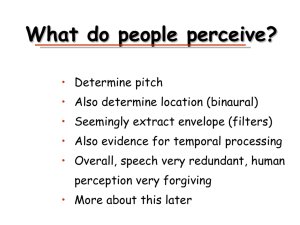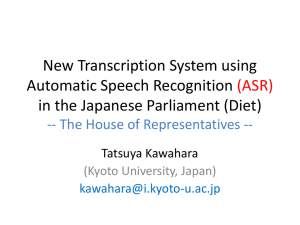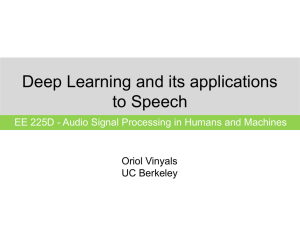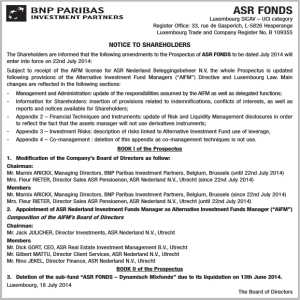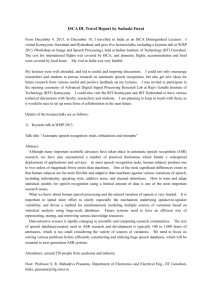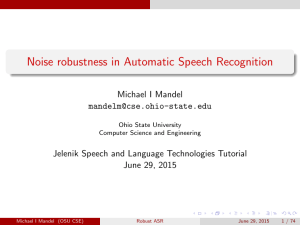No Slide Title
advertisement
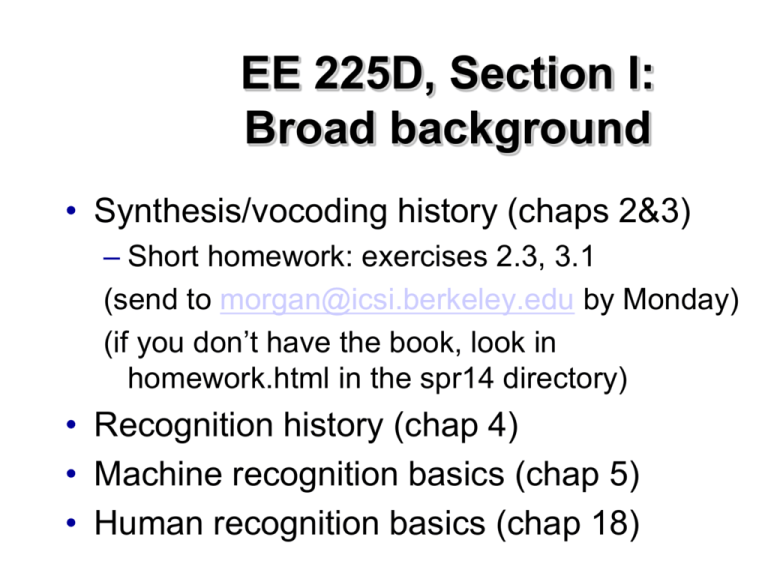
EE 225D, Section I: Broad background • Synthesis/vocoding history (chaps 2&3) – Short homework: exercises 2.3, 3.1 (send to morgan@icsi.berkeley.edu by Monday) (if you don’t have the book, look in homework.html in the spr14 directory) • Recognition history (chap 4) • Machine recognition basics (chap 5) • Human recognition basics (chap 18) (Extremely) Simplified Model of Speech Production Periodic source Noise source voiced unvoiced Filters Coupling Speech Fine structure and spectral envelope of a sustained vowel Channel Vocoder: analysis Channel Vocoder: synthesis What do people perceive? • Determine pitch • Also determine location (binaural) • Seemingly extract envelope (filters) • Also evidence for temporal processing • Overall, speech very redundant, human perception very forgiving • More about this later ASR Intro: Outline • ASR Research History • Difficulties and Dimensions • Core Technology Components • 21st century ASR Research Radio Rex – 1920’s ASR Radio Rex “It consisted of a celluloid dog with an iron base held within its house by an electromagnet against the force of a spring. Current energizing the magnet flowed through a metal bar which was arranged to form a bridge with 2 supporting members. This bridge was sensitive to 500 cps acoustic energy which vibrated it, interrupting the current and releasing the dog. The energy around 500 cps contained in the vowel of the word Rex was sufficient to trigger the device when the dog’s name was called.” 1952 Bell Labs Digits • First word (digit) recognizer • Approximates energy in formants (vocal tract resonances) over word • Already has some robust ideas (insensitive to amplitude, timing variation) • Worked very well • Main weakness was technological (resistors and capacitors) Digit Patterns Axis Crossing Counter HP filter (1 kHz) Limiting Amplifier Spoken (kHz) 3 2 Digit 1 Axis Crossing Counter LP filter (800 Hz) Limiting Amplifier 200 800 (Hz) The 60’s • Better digit recognition • Breakthroughs: Spectrum Estimation (FFT, cepstra, LPC), Dynamic Time Warp (DTW), and Hidden Markov Model (HMM) theory • 1969 Pierce letter to JASA: “Whither Speech Recognition?” Pierce Letter • 1969 JASA • Pierce led Bell Labs Communications Sciences Division • Skeptical about progress in speech recognition, motives, scientific approach • Came after two decades of research by many labs Pierce Letter (Continued) ASR research was government-supported. He asked: •Is this wise? •Are we getting our money’s worth? Purpose for ASR • Talking to machine had (“gone downhill since…….Radio Rex”) Main point: to really get somewhere, need intelligence, language • Learning about speech Main point: need to do science, not just test “mad schemes” 1971-76 ARPA Project • Focus on Speech Understanding • Main work at 3 sites: System Development Corporation, CMU and BBN • Other work at Lincoln, SRI, Berkeley • Goal was 1000-word ASR, a few speakers, connected speech, constrained grammar, less than 10% semantic error Results • Only CMU Harpy fulfilled goals used LPC, segments, lots of high level knowledge, learned from Dragon * (Baker) * The CMU system done in the early ‘70’s; as opposed to the company formed in the ‘80’s Achieved by 1976 • Spectral and cepstral features, LPC • Some work with phonetic features • Incorporating syntax and semantics • Initial Neural Network approaches • DTW-based systems (many) • HMM-based systems (Dragon, IBM) Automatic Speech Recognition Data Collection Pre-processing Feature Extraction (Framewise) Hypothesis Generation Cost Estimator Decoding Framewise Analysis of Speech Frame 1 Frame 2 Feature Vector X1 Feature Vector X2 1970’s Feature Extraction • Filter banks - explicit, or FFT-based • Cepstra - Fourier components of log spectrum • LPC - linear predictive coding (related to acoustic tube) LPC Spectrum LPC Model Order Spectral Estimation Filter Banks Reduced Pitch Effects X Excitation Estimate Direct Access to Spectra X Less Resolution at HF X Orthogonal Outputs Peak-hugging Property Reduced Computation Cepstral Analysis LPC X X X X X X X Dynamic Time Warp • Optimal time normalization with dynamic programming • Proposed by Sakoe and Chiba, circa 1970 • Similar time, proposal by Itakura • Probably Vintsyuk was first (1968) • Good review article by White, in Trans ASSP April 1976 Nonlinear Time Normalization HMMs for Speech • Math from Baum and others, 1966-1972 • Applied to speech by Baker in the original CMU Dragon System (1974) • Developed by IBM (Baker, Jelinek, Bahl, Mercer,….) (1970-1993) • Extended by others in the mid-1980’s A Hidden Markov Model q 1 q P(q | q ) 2 1 P(x | q ) 1 2 q P(q | q ) 3 2 P(x | q ) 2 3 P(q | q ) 4 3 P(x | q ) 3 Markov model (state topology) q q 1 P(x ,x , q ,q 1 2 1 2 2 ) ≈ P( q ) P(x |q ) P(q 1 1 1 2 | q ) P(x | q ) 1 2 2 Markov model (graphical form) q q x x 1 1 2 2 q 3 x 3 q 4 x 4 HMM Training Steps • Initialize estimators and models • Estimate “hidden” variable probabilities • Choose estimator parameters to maximize model likelihoods • Assess and repeat steps as necessary • A special case of Expectation Maximization (EM) The 1980’s • Collection of large standard corpora • Front ends: auditory models, dynamics • Engineering: scaling to large vocabulary continuous speech • Second major (D)ARPA ASR project • HMMs become ready for prime time Standard Corpora Collection • Before 1984, chaos • TIMIT • RM (later WSJ) • ATIS • NIST, ARPA, LDC Front Ends in the 1980’s • Mel cepstrum (Bridle, Mermelstein) • PLP (Hermansky) • Delta cepstrum (Furui) • Auditory models (Seneff, Ghitza, others) Mel Frequency Scale frequency Spectral vs Temporal Processing Analysis (e.g., cepstral) Spectral processing frequency Time Processing (e.g., mean removal) Temporal processing Dynamic Speech Features • temporal dynamics useful for ASR • local time derivatives of cepstra • “delta’’ features estimated over multiple frames (typically 5) • usually augments static features • can be viewed as a temporal filter “Delta” impulse response .2 .1 0 -.1 -.2 -2 -1 0 1 2 frames HMM’s for Continuous Speech • Using dynamic programming for cts speech (Vintsyuk, Bridle, Sakoe, Ney….) • Application of Baker-Jelinek ideas to continuous speech (IBM, BBN, Philips, ...) • Multiple groups developing major HMM systems (CMU, SRI, Lincoln, BBN, ATT) • Engineering development - coping with data, fast computers 2nd (D)ARPA Project • • • • Common task Frequent evaluations Convergence to good, but similar, systems Lots of engineering development - now up to 60,000 word recognition, in real time, on a workstation, with less than 10% word error • Competition inspired others not in project Cambridge did HTK, now widely distributed Knowledge vs. Ignorance • Using acoustic-phonetic knowledge in explicit rules • Ignorance represented statistically • Ignorance-based approaches (HMMs) “won”, but • Knowledge (e.g., segments) becoming statistical • Statistics incorporating knowledge Some 1990’s Issues • Independence to long-term spectrum • Adaptation • Effects of spontaneous speech • Information retrieval/extraction with broadcast material • Query-style/dialog systems (e.g., ATIS, Voyager, BeRP) • Applying ASR technology to related areas (language ID, speaker verification) The Berkeley Restaurant Project (BeRP) 1991-1996 ASR • MFCC/PLP/derivatives widely used • Vocal tract length normalization (VTLN) • Cepstral Mean Subtraction (CMS) or RelAtive SpecTral Analysis (RASTA) • Continuous density HMMs, w/GMMs or ANNs • N-phones, decision-tree clustering • MLLR unsupervised adaptation • Multiple passes via lattices, esp. for longer term language models (LMs) “Towards increasing speech recognition error rates” • May 1996 Speech Communication paper • Pointed out that high risk research choices would typically hurt performance (at first) • Encourage researchers to press on • Suggested particular directions • Many comments from other researchers, e.g., There are very many bad ideas, and it’s still good to do better (you like better scores too) You don’t have the only good ideas What we thought: • We should look at “more time” (than 20 ms) • We should look at better stat models (weaken conditional independence assumptions) • We should look at smaller chunks of the spectrum and combine information later • We should work on improving models of confidence/rejection (knowing when we do not know) How did we do? • Best systems look at 100 ms or more • Stat models being explored, but HMM still king • Multiband still has limited application, but multiple streams/models/cross-adaptation are widely used • Real systems depend heavily on confidence measures; research systems use for combining The Question Man • Queried 3 of the best known system builders for today’s large ASR engines: “In your opinion, what have been the most important advances in ASR in the last 10 years?” [asked in late 2006] Major advances in mainstream systems since 1996- experts 1+2 • Front end per se (e.g., adding in PLP) • Normalization (VTLN, mean & variance) • Adaptation/feature transformation (MLLR, HLDA, fMPE) • Discriminative training (MMI, MPE) • Improved n-gram smoothing, other LMs • Handling lots of data (e.g., lower quality transcripts, broader context) • Combining systems (e.g., confusion networks or “sausages”) • Multiple passes using lattices, etc. • Optimizing for speed Major advances in mainstream systems since 1996- expert 3 • Training w/ Canonicalized features: feature space MLLR, VTLN, SAT • Discriminative features: feature-space MPE, LDA+MLLT instead of ∆ and ∆ ∆ • Essentially no improvement in LMs • Discriminative training (MMI, MPE) effects are duplicated by f-MPE, little or no improvement to do both • Bottom line: better systems by “feeding better features into the machinery” What is an “important advance”? • Definition assumed by the experts I queried: ideas that made systems work (significantly) better • A broader definition: ideas that led to significant improvements either by themselves or through stimulation of related research • Also: include promising directions? Major directions since 1991- my view • Front end - PLP, ANN-based features, many others, and (most importantly) multiple streams of features • Normalization – mean & variance, VTLN, RASTA • Adaptation/feature transformation • Discriminative training - I would add ANN trainings • Effects of spontaneous speech - very important! • Handling lots of data • Combining systems or subsystems • New frameworks that could encourage innovation (e.g., graphical models, FSMs) • Optimizing for speed - including hardware Also - “Beyond the Words” (Pointed out by expert #1) • Hidden events sentence boundaries punctuation diarization (who spoke when) • Dialog Acts • Emotion • Prosodic modeling for all of the above Major advances since the survey • The resurrection of neural networks Gradual adoption of NNLMs (just as an assist) Bigger effect in acoustic modeling – “deep” approaches • Some newer advances in “front ends”, including multi-mic (as in iphones) • Rapid porting/cross lingual • Lots more computing! Lots more data! • Many more applications (e.g., Siri) • Many more users, jobs, interest Where Pierce Letter Applies • We still need science • Need language, intelligence • Acoustic robustness still poor • Perceptual research, models • Fundamentals of statistical pattern recognition for sequences • Robustness to accent, stress, rate of speech, …….. Progress in 30 Years • From digits to 60,000 words or more • From single speakers to many • From isolated words to continuous speech • From read speech to fluent speech • From no products to many products, some systems actually saving LOTS of money Real Uses • Telephone: phone company services (collect versus credit card) • Telephone: call centers for query information (e.g., stock quotes, parcel tracking, 800-GOOG-411) • Dictation products: continuous recognition, speaker dependent/adaptive But: • Still <97% accurate on “yes” for telephone • Unexpected rate of speech hurts • Performance in noise, reverb still bad • Unexpected accent hurts badly • Accuracy on unrestricted speech at 50-70% • Don’t know when we know • Few advances in basic understanding • Time, resources for each new task, language Confusion Matrix for Digit Recognition (~1996) 4 5 6 7 8 9 0 Error Rate 0 5 1 0 1 0 2 0 4.5 188 2 0 0 1 3 0 0 6 6.0 0 3 191 0 1 0 2 0 3 0 4.5 4 8 0 0 187 4 0 1 0 0 0 6.5 5 0 0 0 0 193 0 0 0 7 0 3.5 6 0 0 0 0 1 196 0 2 0 1 2.0 7 2 2 0 2 0 1 190 0 1 2 5.0 8 0 1 0 0 1 2 2 196 0 0 2.0 9 5 0 2 0 8 0 3 0 179 3 10.5 0 1 4 0 0 0 1 1 0 1 192 4.5 Class 1 2 1 191 0 2 0 3 3 Overall error rate 4.85% Dealing with the real world (also ~1996) • Account number: • Counting • “Marco Polo” • Dialog Large Vocabulary CSR Error Rate % 12 • 9 • 6 Ø • 1 • 3 ‘88 ‘89 ‘90 ‘91 ‘92 ‘93 --- RM ( 1K words, PP ~ ~ 60) ___ WSJØ, WSJ1 (5K, 20-60K words, PP ~ ~ 100) ‘94 Year Large Vocabulary CSR Error Rate % 12 • 9 • 6 • Ø • 1 • 3 ‘88 ‘89 ‘90 ‘91 ‘92 ‘93 --- RM ( 1K words, PP ~ ~ 60) ___ WSJØ, WSJ1 (5K, 20-60K words, PP ~ ~ 100) ‘94 Year Why is ASR Hard? • Natural speech is continuous • Natural speech has disfluencies • Natural speech is variable over: global rate, local rate, pronunciation within speaker, pronunciation across speakers, phonemes in different contexts Why is ASR Hard? (continued) • Large vocabularies are confusable • Out of vocabulary words inevitable • Recorded speech is variable over: room acoustics, channel characteristics, background noise • Large training times are not practical • User expectations are for equal to or greater than “human performance” Main Causes of Speech Variability Environment Speech - correlated noise reverberation, reflection Uncorrelated noise additive noise (stationary, nonstationary) Attributes of speakers dialect, gender, age Speaker Input Equipment Manner of speaking breath & lip noise stress Lombard effect rate level pitch cooperativeness Microphone (Transmitter) Distance from microphone Filter Transmission system distortion, noise, echo Recording equipment ASR Dimensions • Speaker dependent, independent • Isolated, continuous, keywords • Lexicon size and difficulty • Task constraints, perplexity • Adverse or easy conditions • Natural or read speech Telephone Speech • • • • • • Limited bandwidth (F vs S) Large speaker variability Large noise variability Channel distortion Different handset microphones Mobile and handsfree acoustics Sample domain: alphabet • • • • • E set: B C D G P T V Z A set: J K EH set: M N F S AH set: I Y R Difficult even though it is small The basics ASR Prehistory ~1920 ~1952 Some improvements Lots of Engineering Something + Moore’s Law works + promising directions ~1976 ~1991 What will happen in the “ultraviolet” period? Or, actually, What should happen in the “ultraviolet” period? 2014 What’s likely to help • The obvious: faster computers, more memory and disk, more data • Improved techniques for learning from unlabeled data • Serious efforts to handle: • noise and reverb • speaking style variation • out-of-vocabulary words (and sounds) • Learning how to select features • Learning how to select models • Feedback from downstream processing Also • New (multiple) features and models • Including “deep” approaches • New statistical dependencies (e.g., graphical models) • Multiple time scales • Multiple (larger) sound units • Dynamic/robust pronunciation models • Language models including structure (still!) • Incorporating prosody • Incorporating meaning • Non-speech modalities • Understanding confidence Automatic Speech Recognition Data Collection Pre-processing Feature Extraction Hypothesis Generation Cost Estimator Decoding Data Collection + Pre-processing Speech Room Acoustics Microphone Linear Filtering Issue: Effect on modeling Sampling & Digitization Feature Extraction Spectral Analysis Auditory Model/ Normalizations Issue: Design for discrimination Representations are Important Speech waveform 23% frame correct Network PLP features 70% frame correct Network Hypothesis Generation cat dog a cat not is adog a dog is not a cat Issue: models of language and task Cost Estimation • Distances • Negative Log probabilities, from discrete distributions Gaussians, mixtures neural networks Decoding Pronunciation Models Language Models Most likely words for largest product P(acoustics|words) X P(words) P(words) = Π P(words|history) •bigram, history is previous word •trigram, history is previous 2 words •n-gram, history is previous n-1 words System Architecture Grammar Cepstrum Speech Signal Signal Processing Probability Estimator Probabilities “z” -0.81 “th” = 0.15 “t” = 0.03 Decoder Recognized Words “zero” “three” “two” Pronunciation Lexicon What’s Hot in Research • Speech in noisy environments – Aurora, “RATS” • Portable (e.g., cellular) ASR, assistants (Siri etc) • Trans-/multi- lingual conversational speech (EARS->GALE->BOLT,BABEL) • Shallow understanding of deep speech • Question answering/summarization • Understanding meetings – or at least browsing them • Voice/keyword search • Multimodal/Multimedia 21st Century ASR Research • New (multiple) features and models • More to learn from the brain? • Deep learning approaches • New statistical dependencies • • • • • • • • • Learning what’s important Multiple time scales Multiple (larger) sound units (segments?) Dynamic/robust pronunciation models Long-range language models Incorporating prosody Incorporating meaning Non-speech modalities Understanding confidence Summary • Current ASR based on 60 years of research • Core algorithms -> products, 10-30 yrs • Deeply difficult, but tasks can be chosen that are easier in SOME dimension • Much more yet to do, but • Much can be done with current technology
